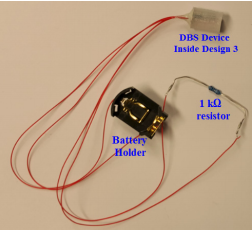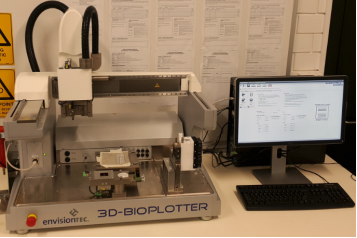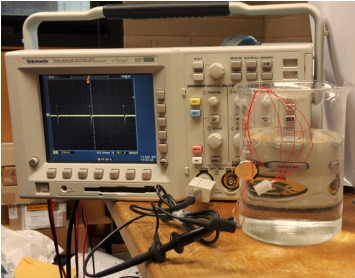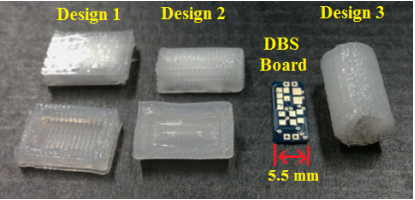Deep brain stimulation (DBS) is a method for treating a variety of neurological disorders such as Multiple Sclerosis and Parkinson’s. In DBS treatment, electrical signals are delivered to a very specific region of the brain through an electrode attached to a microdevice. An area of primary concern in the continued development of these devices for DBS is the manner by which they can be made biocompatible. These devices are made up of components such as wires, a circuit board, resistors and capacitors, and coin-cell batteries and when implanted under the skin, the body recognizes these as non-native, harmful intrusions that should be repelled by its immune system’s defenses.
 There have been a variety of efforts made to create DBS devices that would not be rejected by a patient’s body. The most successful of these methods has involved the creation of a silicone enclosure for the device. Silicone is an excellent material for this type of application because in addition to its inherently biocompatible make up, it is also extremely flexible, elastic, and resilient.
There have been a variety of efforts made to create DBS devices that would not be rejected by a patient’s body. The most successful of these methods has involved the creation of a silicone enclosure for the device. Silicone is an excellent material for this type of application because in addition to its inherently biocompatible make up, it is also extremely flexible, elastic, and resilient.
The difficulty in moving forward with its utilization as the primary method for the containment of DBS devices has been the methods by which it can be applied. The means by which a DBS device can be coated with silicone have been restricted to dipping or molding, although each method comes with its own weaknesses. Dipping the devices to create a silicone coating is a low-cost method for producing a small number of devices but coating formation cannot be sufficiently precisely controlled. Creating molds for the devices offers higher levels of control but also comes with a much higher price tag and the methods by which the molds are created requires a significant investment making it unsuitable for low-volume production.
 In a recent paper published in the proceedings of The International Design Technology Conference held in Geelong, Australia, a team of researchers from Deakin University and the Mayo Clinic presented a novel approach for creating the biocompatible enclosures for these electronic implants. In this paper, the authors proposed that 3D printing the silicone enclosures on a bioplotter could be the most viable method for the creation of implantable DBS devices.
In a recent paper published in the proceedings of The International Design Technology Conference held in Geelong, Australia, a team of researchers from Deakin University and the Mayo Clinic presented a novel approach for creating the biocompatible enclosures for these electronic implants. In this paper, the authors proposed that 3D printing the silicone enclosures on a bioplotter could be the most viable method for the creation of implantable DBS devices.
To test the viability of such an approach, the research team first designed the enclosures using SolidWorks and then sent the models to be printed on an EnvisionTEC GmbH 3D Bioplotter.
In their paper, they described the method by which this printer generates its physical output:
“Multiple materials [can be] inserted using syringes moving in three dimensions. Pressure is applied to the syringes, which then deposit a strand of materials for the length of movement and the time that the pressure is applied. Parallel strands are printed in one layer. For the following layer, the direction of the strands is turned to the centre of the object, creating a mesh with good mechanical properties and mathematically defined porosity. The features of the system include a 3-axis positioning system with high movement accuracy, cell printing with up to five types of cells per object, high flexibility in the choice of materials, fast printing speed, a large build volume, and flexible inner structure design.”
 For their experiments, three enclosure designs, created so as to be printable without the use of support material, were generated and printed in commercial grade silicone. The team then worked to assess the suitability of these enclosures as mechanisms by which DBS devices can be implanted. In order to do this, they were submitted to two tests, one in which they were submersed in water to determine seal quality, and the second in which their performance was monitored while submersed. Both tests demonstrated 3D printing silicone to be a successful method for the creation of DBS enclosures.
For their experiments, three enclosure designs, created so as to be printable without the use of support material, were generated and printed in commercial grade silicone. The team then worked to assess the suitability of these enclosures as mechanisms by which DBS devices can be implanted. In order to do this, they were submitted to two tests, one in which they were submersed in water to determine seal quality, and the second in which their performance was monitored while submersed. Both tests demonstrated 3D printing silicone to be a successful method for the creation of DBS enclosures.
While there is a great deal more testing that needs to be done and more possibilities for refinement of the enclosure design, at the very least these initial experiments demonstrate the enormous potential that this method holds for the creation of biocompatible DBS devices.
You can review the paper here. Join the discussion of this research in the 3D Printed DBS Device Enclosures forum thread over at 3DPB.com.
Subscribe to Our Email Newsletter
Stay up-to-date on all the latest news from the 3D printing industry and receive information and offers from third party vendors.
You May Also Like
3D Printing Webinar and Event Roundup: May 5, 2024
We’ve got a busy week of 3D printing events ahead of us, in Texas, Florida, Washington, D.C., Shanghai, and more. Webinar offerings will cover medical models, PolyJet 3D printing, additive...
High Stakes, High Speed: KVG Acquires 15 Nexa3D HSE 3D Printers to Boost Military Tech
As 3D printing increasingly intersects with defense and military logistics, a new partnership between Nexa3D and mission support logistics firm KVG stresses the growing importance of this technology in strategic...
Construction 3D Printing CEO Reflects on Being Female in Construction
Natalie Wadley, CEO of ChangeMaker3D, could hear the words of her daughter sitting next to her resounding in her head. “Mum, MUM, you’ve won!” Wadley had just won the prestigious...
3D Printing News Briefs, February 17, 2024: Shot Blasting, Service Bureaus, & More
In today’s 3D Printing News Briefs, we’re starting out with post-processing, as SKZ Würzburg is using a shot blast system from AM Solutions for its research. Moving on to business,...
































